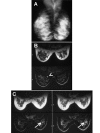Prospective screening study of 0.5 Tesla dedicated magnetic resonance imaging for the detection of breast cancer in young, high-risk women
- PMID: 16800895
- PMCID: PMC1553433
- DOI: 10.1186/1472-6874-6-10
Prospective screening study of 0.5 Tesla dedicated magnetic resonance imaging for the detection of breast cancer in young, high-risk women
Abstract
Background: Evidence-based screening guidelines are needed for women under 40 with a family history of breast cancer, a BRCA1 or BRCA2 mutation, or other risk factors. An accurate assessment of breast cancer risk is required to balance the benefits and risks of surveillance, yet published studies have used narrow risk assessment schemata for enrollment. Breast density limits the sensitivity of film-screen mammography but is not thought to pose a limitation to MRI, however the utility of MRI surveillance has not been specifically examined before in women with dense breasts. Also, all MRI surveillance studies yet reported have used high strength magnets that may not be practical for dedicated imaging in many breast centers. Medium strength 0.5 Tesla MRI may provide an alternative economic option for surveillance.
Methods: We conducted a prospective, nonrandomized pilot study of 30 women age 25-49 years with dense breasts evaluating the addition of 0.5 Tesla MRI to conventional screening. All participants had a high quantitative breast cancer risk, defined as > or = 3.5% over the next 5 years per the Gail or BRCAPRO models, and/or a known BRCA1 or BRCA2 germline mutation.
Results: The average age at enrollment was 41.4 years and the average 5-year risk was 4.8%. Twenty-two subjects had BIRADS category 1 or 2 breast MRIs (negative or probably benign), whereas no category 4 or 5 MRIs (possibly or probably malignant) were observed. Eight subjects had BIRADS 3 results, identifying lesions that were "probably benign", yet prompting further evaluation. One of these subjects was diagnosed with a stage T1aN0M0 invasive ductal carcinoma, and later determined to be a BRCA1 mutation carrier.
Conclusion: Using medium-strength MRI we were able to detect 1 early breast tumor that was mammographically undetectable among 30 young high-risk women with dense breasts. These results support the concept that breast MRI can enhance surveillance for young high-risk women with dense breasts, and further suggest that a medium-strength instrument is sufficient for this application. For the first time, we demonstrate the use of quantitative breast cancer risk assessment via a combination of the Gail and BRCAPRO models for enrollment in a screening trial.
Figures


References
-
- Burhenne HJ, Burhenne LW, Goldberg F, Hislop TG, Worth AJ, Rebbeck PM, Kan L. Interval breast cancers in the Screening Mammography Program of British Columbia: analysis and classification. Am J Roentgenol. 1994;162:1067–1071. discussion 162:1072–1075. - PubMed
-
- Robertson CL. A private breast imaging practice: medical audit of 25,788 screening and 1,077 diagnostic examinations. Radiology. 1993;187:75–79. - PubMed
-
- Humphrey LL, Helfand M, Chan BK, Woolf SH. Breast cancer screening: a summary of the evidence for the U.S. Preventive Services Task Force. Ann Intern Med. 2002;137:347–360. - PubMed
-
- Wolfe JN. Breast parenchymal patterns and their changes with age. Radiology. 1976;121:545–552. - PubMed
Grants and funding
LinkOut - more resources
Full Text Sources
Miscellaneous

